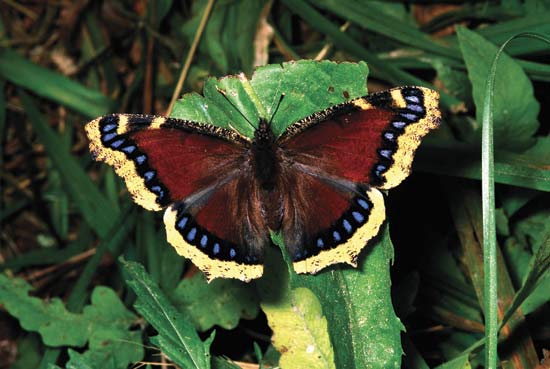|
The mourning cloak (Nymphalis antiopa)is one of the first butterflies to re-emerge in North Carolina. This species is the longest lived in the United States, surviving up to 11 months. The adults are dormant in winter, and then re-emerge, wings imperfect and worn, during the first warm days of late winter and early spring.
This time of year, males are quite bold, bravely chasing birds out of their 300 square meter territories. In early spring, males and females perform a beautiful mating dance, spiraling upward through the air. The females will then lay clusters of eggs on their favorite food plants, black willows, as well as other willow species, elms, birches and hackberries. Although the females die shortly thereafter, caterpillars will emerge from the eggs in April. After three weeks, this brood will have pupated and emerged as fresh, young mourning cloaks. The adult mourning cloaks are usually found in woodlands, where they feed on tree sap (especially oak sap), rotting fruit and occasionally nectar, and build up stores for the winter. Did you know?
Identification: The mourning cloak has brown wings with small blue spots bordering a yellow edge. It reaches 2 ¼ to 4 inches in length. |
About UsECWA's vision is a living creek connecting human and natural communities in Durham. Through land acquisition, collaboration with the city, and public education, we hope to create a Durham where residents can bike or walk across the watershed and stop at local businesses and nature preserves along the way. Archives
February 2024
Categories
All
|
ECWA
Ellerbe Creek Watershed Association
Office: 904 Broad St Durham, NC 27705 | Mailing: PO Box 2679 Durham, NC 27715
919.698.9729 | [email protected]
919.698.9729 | [email protected]
Copyright ©ECWA

 RSS Feed
RSS Feed
